Analysis of ADR and Design-Build in Construction Contracts
VerifiedAdded on 2023/06/13
|11
|3033
|291
Report
AI Summary
This report provides an overview of construction contracts, focusing on Alternative Dispute Resolution (ADR) methods and design-build strategies. It begins by highlighting the prevalence of disputes in the construction industry and the limitations of traditional litigation, leading to the exploration of ADR as a more efficient and collaborative approach. The report evaluates various ADR routes, including negotiation, conciliation, mediation, adjudication, and arbitration, detailing their processes, advantages, and disadvantages. Furthermore, it assesses the design-build strategy, examining its features, benefits such as cost savings and increased contractor involvement, and drawbacks like potential limitations in design flexibility. The report concludes by advocating for the adoption of the design-build approach based on its demonstrated success in project deliveries.
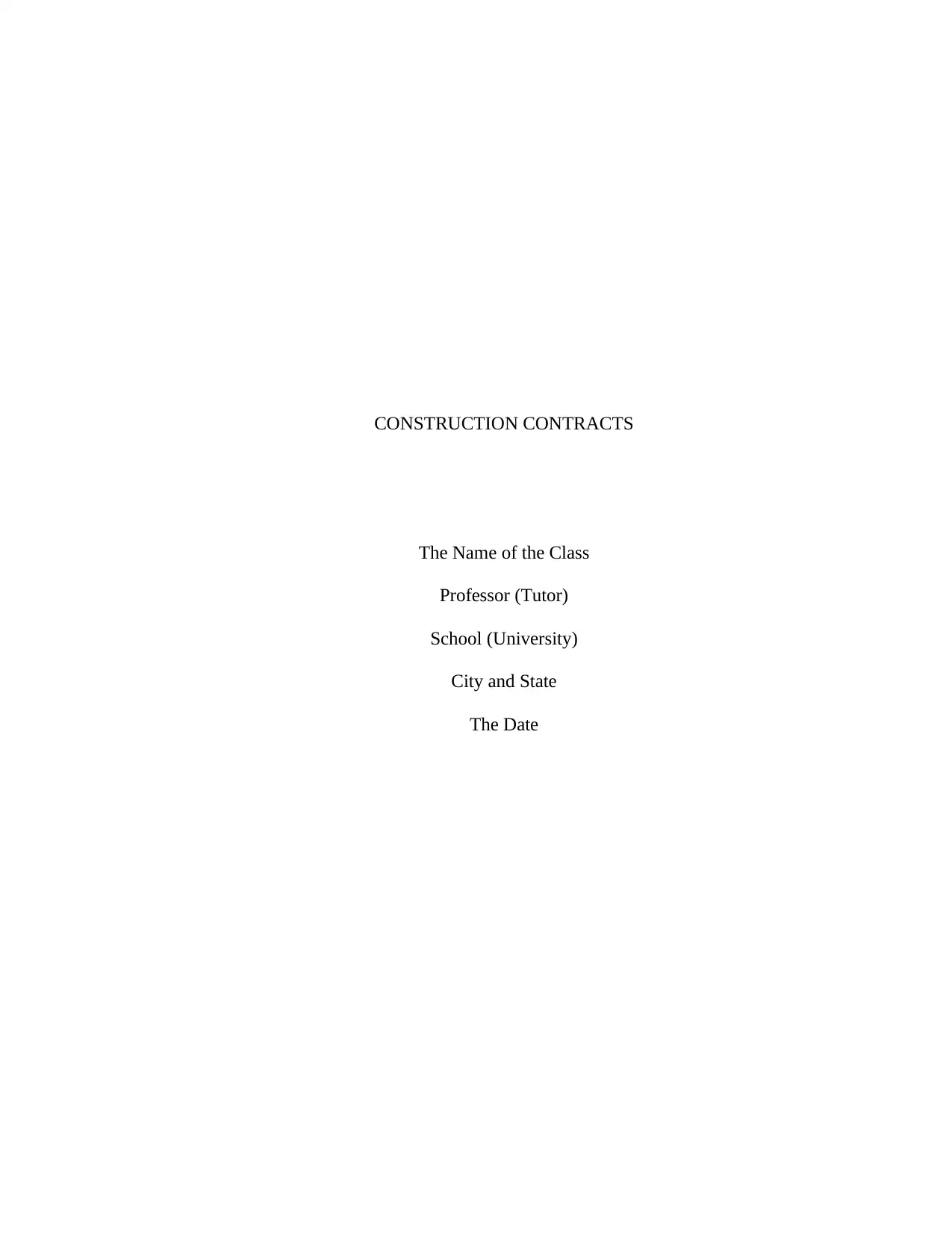
CONSTRUCTION CONTRACTS
The Name of the Class
Professor (Tutor)
School (University)
City and State
The Date
The Name of the Class
Professor (Tutor)
School (University)
City and State
The Date
Paraphrase This Document
Need a fresh take? Get an instant paraphrase of this document with our AI Paraphraser
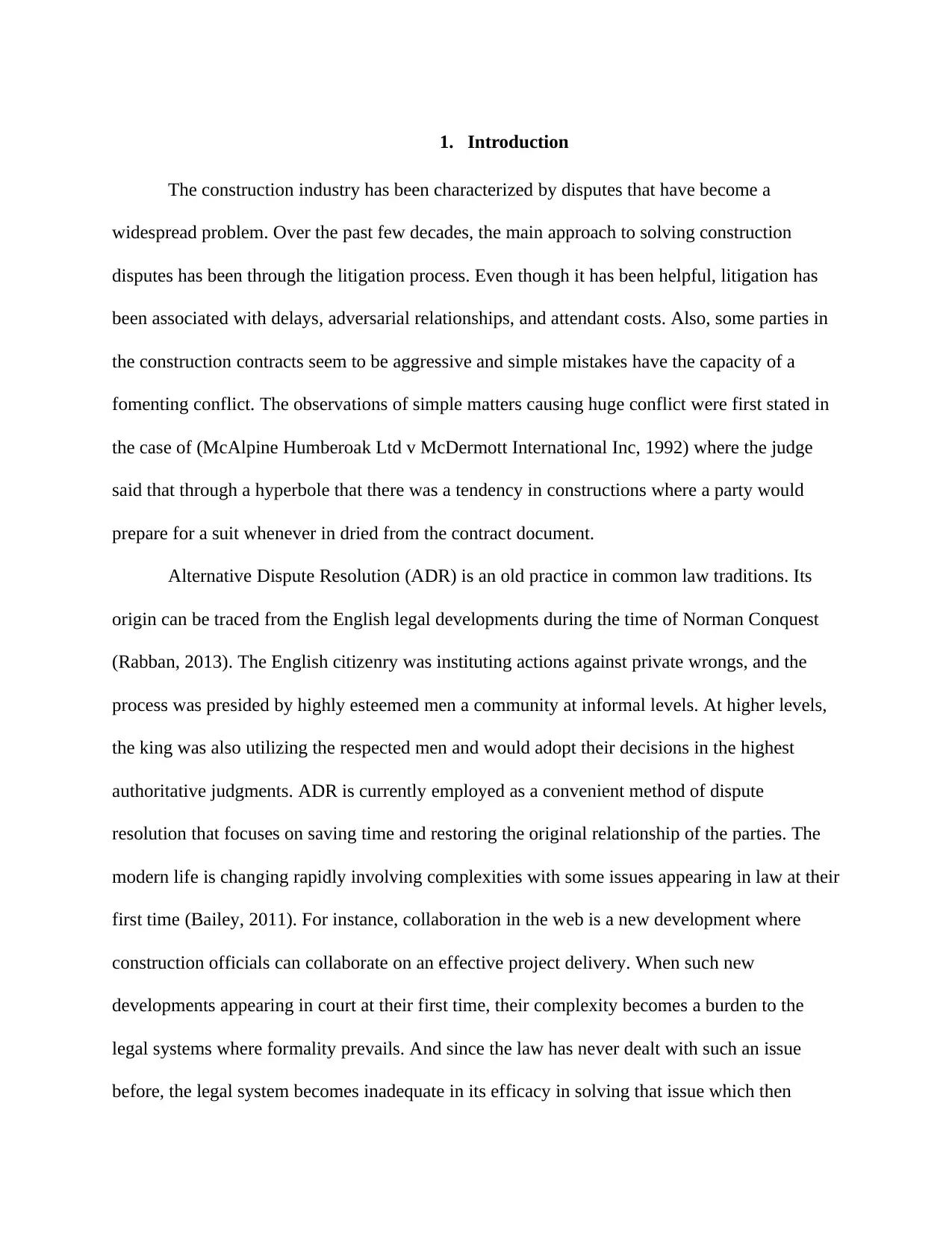
1. Introduction
The construction industry has been characterized by disputes that have become a
widespread problem. Over the past few decades, the main approach to solving construction
disputes has been through the litigation process. Even though it has been helpful, litigation has
been associated with delays, adversarial relationships, and attendant costs. Also, some parties in
the construction contracts seem to be aggressive and simple mistakes have the capacity of a
fomenting conflict. The observations of simple matters causing huge conflict were first stated in
the case of (McAlpine Humberoak Ltd v McDermott International Inc, 1992) where the judge
said that through a hyperbole that there was a tendency in constructions where a party would
prepare for a suit whenever in dried from the contract document.
Alternative Dispute Resolution (ADR) is an old practice in common law traditions. Its
origin can be traced from the English legal developments during the time of Norman Conquest
(Rabban, 2013). The English citizenry was instituting actions against private wrongs, and the
process was presided by highly esteemed men a community at informal levels. At higher levels,
the king was also utilizing the respected men and would adopt their decisions in the highest
authoritative judgments. ADR is currently employed as a convenient method of dispute
resolution that focuses on saving time and restoring the original relationship of the parties. The
modern life is changing rapidly involving complexities with some issues appearing in law at their
first time (Bailey, 2011). For instance, collaboration in the web is a new development where
construction officials can collaborate on an effective project delivery. When such new
developments appearing in court at their first time, their complexity becomes a burden to the
legal systems where formality prevails. And since the law has never dealt with such an issue
before, the legal system becomes inadequate in its efficacy in solving that issue which then
The construction industry has been characterized by disputes that have become a
widespread problem. Over the past few decades, the main approach to solving construction
disputes has been through the litigation process. Even though it has been helpful, litigation has
been associated with delays, adversarial relationships, and attendant costs. Also, some parties in
the construction contracts seem to be aggressive and simple mistakes have the capacity of a
fomenting conflict. The observations of simple matters causing huge conflict were first stated in
the case of (McAlpine Humberoak Ltd v McDermott International Inc, 1992) where the judge
said that through a hyperbole that there was a tendency in constructions where a party would
prepare for a suit whenever in dried from the contract document.
Alternative Dispute Resolution (ADR) is an old practice in common law traditions. Its
origin can be traced from the English legal developments during the time of Norman Conquest
(Rabban, 2013). The English citizenry was instituting actions against private wrongs, and the
process was presided by highly esteemed men a community at informal levels. At higher levels,
the king was also utilizing the respected men and would adopt their decisions in the highest
authoritative judgments. ADR is currently employed as a convenient method of dispute
resolution that focuses on saving time and restoring the original relationship of the parties. The
modern life is changing rapidly involving complexities with some issues appearing in law at their
first time (Bailey, 2011). For instance, collaboration in the web is a new development where
construction officials can collaborate on an effective project delivery. When such new
developments appearing in court at their first time, their complexity becomes a burden to the
legal systems where formality prevails. And since the law has never dealt with such an issue
before, the legal system becomes inadequate in its efficacy in solving that issue which then
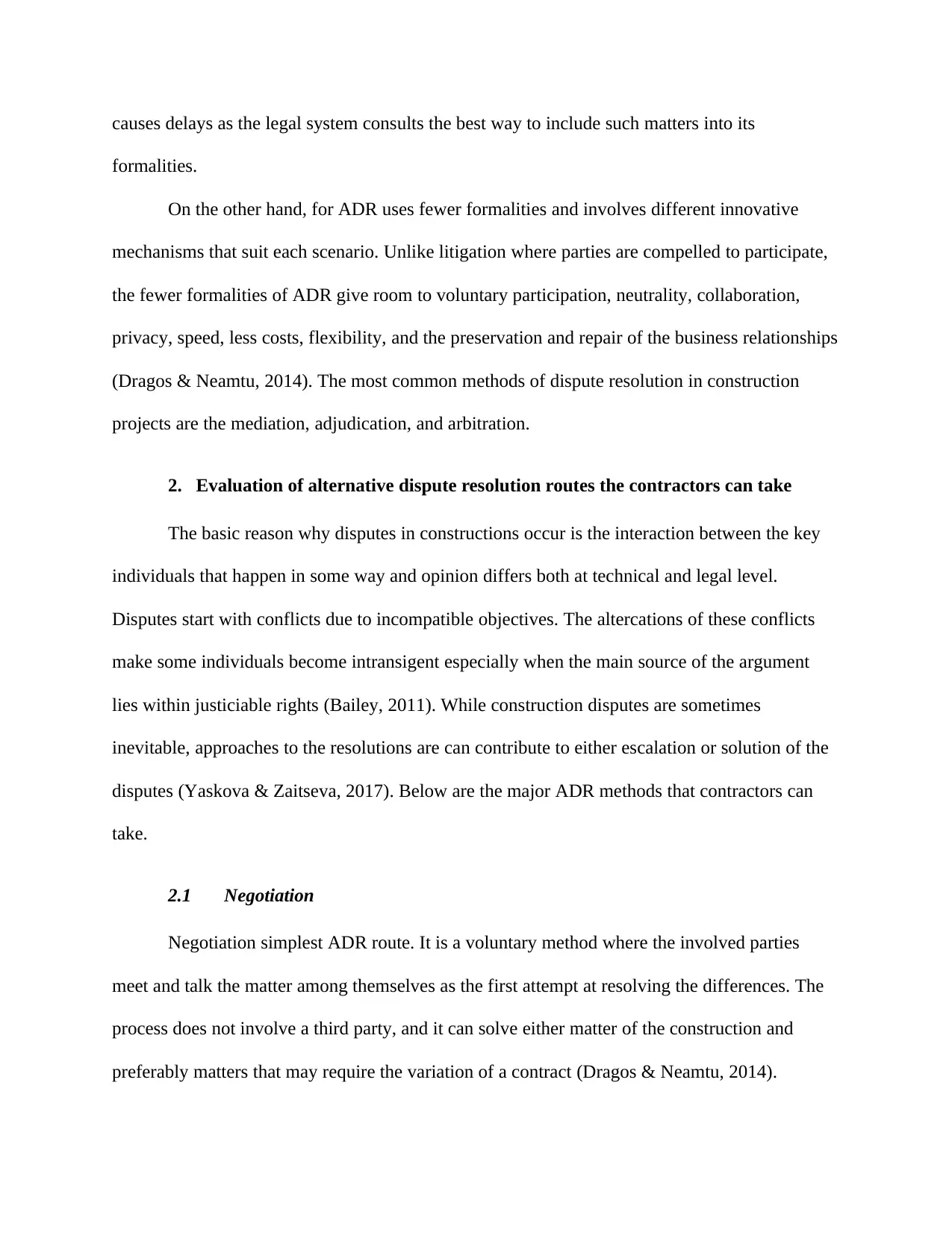
causes delays as the legal system consults the best way to include such matters into its
formalities.
On the other hand, for ADR uses fewer formalities and involves different innovative
mechanisms that suit each scenario. Unlike litigation where parties are compelled to participate,
the fewer formalities of ADR give room to voluntary participation, neutrality, collaboration,
privacy, speed, less costs, flexibility, and the preservation and repair of the business relationships
(Dragos & Neamtu, 2014). The most common methods of dispute resolution in construction
projects are the mediation, adjudication, and arbitration.
2. Evaluation of alternative dispute resolution routes the contractors can take
The basic reason why disputes in constructions occur is the interaction between the key
individuals that happen in some way and opinion differs both at technical and legal level.
Disputes start with conflicts due to incompatible objectives. The altercations of these conflicts
make some individuals become intransigent especially when the main source of the argument
lies within justiciable rights (Bailey, 2011). While construction disputes are sometimes
inevitable, approaches to the resolutions are can contribute to either escalation or solution of the
disputes (Yaskova & Zaitseva, 2017). Below are the major ADR methods that contractors can
take.
2.1 Negotiation
Negotiation simplest ADR route. It is a voluntary method where the involved parties
meet and talk the matter among themselves as the first attempt at resolving the differences. The
process does not involve a third party, and it can solve either matter of the construction and
preferably matters that may require the variation of a contract (Dragos & Neamtu, 2014).
formalities.
On the other hand, for ADR uses fewer formalities and involves different innovative
mechanisms that suit each scenario. Unlike litigation where parties are compelled to participate,
the fewer formalities of ADR give room to voluntary participation, neutrality, collaboration,
privacy, speed, less costs, flexibility, and the preservation and repair of the business relationships
(Dragos & Neamtu, 2014). The most common methods of dispute resolution in construction
projects are the mediation, adjudication, and arbitration.
2. Evaluation of alternative dispute resolution routes the contractors can take
The basic reason why disputes in constructions occur is the interaction between the key
individuals that happen in some way and opinion differs both at technical and legal level.
Disputes start with conflicts due to incompatible objectives. The altercations of these conflicts
make some individuals become intransigent especially when the main source of the argument
lies within justiciable rights (Bailey, 2011). While construction disputes are sometimes
inevitable, approaches to the resolutions are can contribute to either escalation or solution of the
disputes (Yaskova & Zaitseva, 2017). Below are the major ADR methods that contractors can
take.
2.1 Negotiation
Negotiation simplest ADR route. It is a voluntary method where the involved parties
meet and talk the matter among themselves as the first attempt at resolving the differences. The
process does not involve a third party, and it can solve either matter of the construction and
preferably matters that may require the variation of a contract (Dragos & Neamtu, 2014).
⊘ This is a preview!⊘
Do you want full access?
Subscribe today to unlock all pages.

Trusted by 1+ million students worldwide
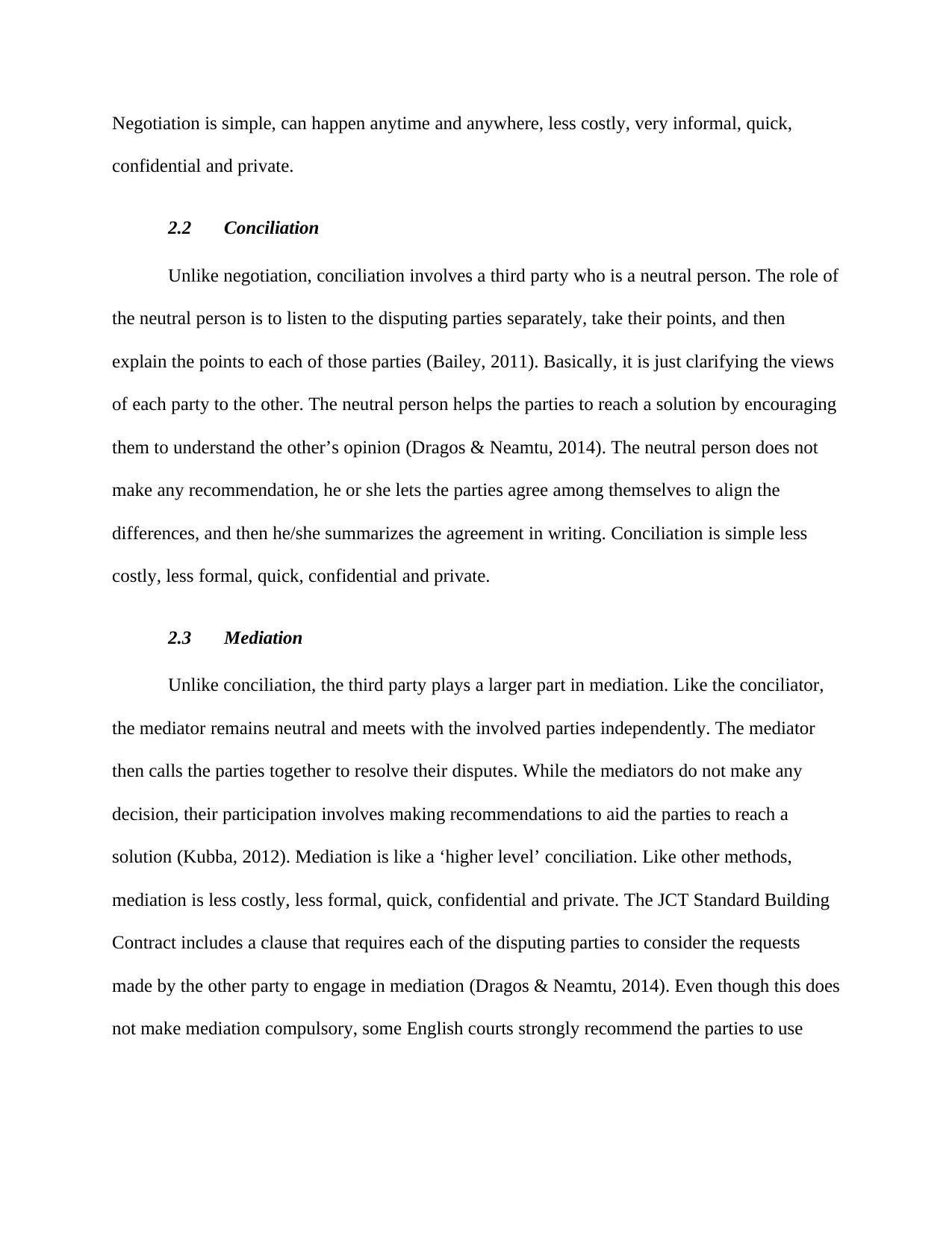
Negotiation is simple, can happen anytime and anywhere, less costly, very informal, quick,
confidential and private.
2.2 Conciliation
Unlike negotiation, conciliation involves a third party who is a neutral person. The role of
the neutral person is to listen to the disputing parties separately, take their points, and then
explain the points to each of those parties (Bailey, 2011). Basically, it is just clarifying the views
of each party to the other. The neutral person helps the parties to reach a solution by encouraging
them to understand the other’s opinion (Dragos & Neamtu, 2014). The neutral person does not
make any recommendation, he or she lets the parties agree among themselves to align the
differences, and then he/she summarizes the agreement in writing. Conciliation is simple less
costly, less formal, quick, confidential and private.
2.3 Mediation
Unlike conciliation, the third party plays a larger part in mediation. Like the conciliator,
the mediator remains neutral and meets with the involved parties independently. The mediator
then calls the parties together to resolve their disputes. While the mediators do not make any
decision, their participation involves making recommendations to aid the parties to reach a
solution (Kubba, 2012). Mediation is like a ‘higher level’ conciliation. Like other methods,
mediation is less costly, less formal, quick, confidential and private. The JCT Standard Building
Contract includes a clause that requires each of the disputing parties to consider the requests
made by the other party to engage in mediation (Dragos & Neamtu, 2014). Even though this does
not make mediation compulsory, some English courts strongly recommend the parties to use
confidential and private.
2.2 Conciliation
Unlike negotiation, conciliation involves a third party who is a neutral person. The role of
the neutral person is to listen to the disputing parties separately, take their points, and then
explain the points to each of those parties (Bailey, 2011). Basically, it is just clarifying the views
of each party to the other. The neutral person helps the parties to reach a solution by encouraging
them to understand the other’s opinion (Dragos & Neamtu, 2014). The neutral person does not
make any recommendation, he or she lets the parties agree among themselves to align the
differences, and then he/she summarizes the agreement in writing. Conciliation is simple less
costly, less formal, quick, confidential and private.
2.3 Mediation
Unlike conciliation, the third party plays a larger part in mediation. Like the conciliator,
the mediator remains neutral and meets with the involved parties independently. The mediator
then calls the parties together to resolve their disputes. While the mediators do not make any
decision, their participation involves making recommendations to aid the parties to reach a
solution (Kubba, 2012). Mediation is like a ‘higher level’ conciliation. Like other methods,
mediation is less costly, less formal, quick, confidential and private. The JCT Standard Building
Contract includes a clause that requires each of the disputing parties to consider the requests
made by the other party to engage in mediation (Dragos & Neamtu, 2014). Even though this does
not make mediation compulsory, some English courts strongly recommend the parties to use
Paraphrase This Document
Need a fresh take? Get an instant paraphrase of this document with our AI Paraphraser
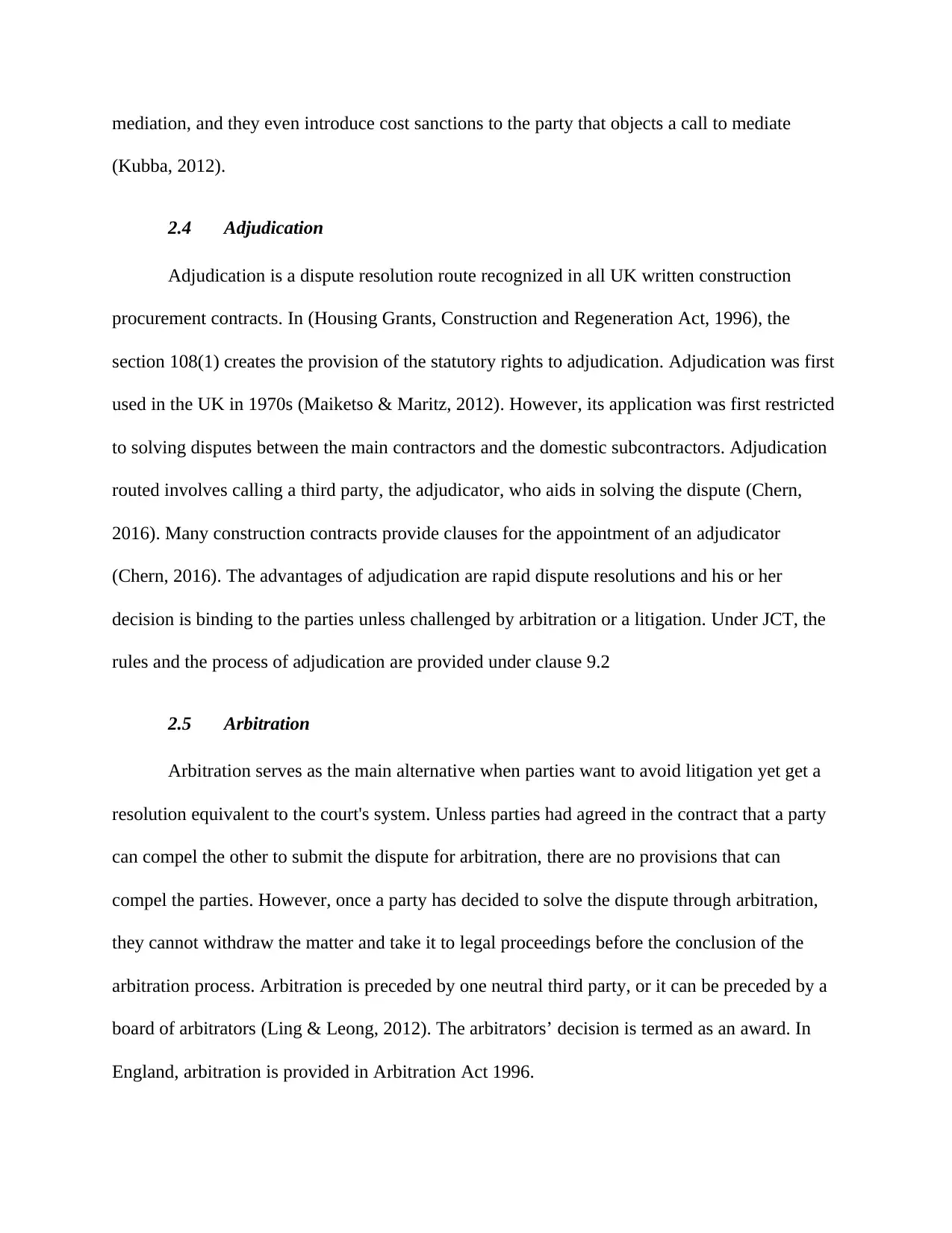
mediation, and they even introduce cost sanctions to the party that objects a call to mediate
(Kubba, 2012).
2.4 Adjudication
Adjudication is a dispute resolution route recognized in all UK written construction
procurement contracts. In (Housing Grants, Construction and Regeneration Act, 1996), the
section 108(1) creates the provision of the statutory rights to adjudication. Adjudication was first
used in the UK in 1970s (Maiketso & Maritz, 2012). However, its application was first restricted
to solving disputes between the main contractors and the domestic subcontractors. Adjudication
routed involves calling a third party, the adjudicator, who aids in solving the dispute (Chern,
2016). Many construction contracts provide clauses for the appointment of an adjudicator
(Chern, 2016). The advantages of adjudication are rapid dispute resolutions and his or her
decision is binding to the parties unless challenged by arbitration or a litigation. Under JCT, the
rules and the process of adjudication are provided under clause 9.2
2.5 Arbitration
Arbitration serves as the main alternative when parties want to avoid litigation yet get a
resolution equivalent to the court's system. Unless parties had agreed in the contract that a party
can compel the other to submit the dispute for arbitration, there are no provisions that can
compel the parties. However, once a party has decided to solve the dispute through arbitration,
they cannot withdraw the matter and take it to legal proceedings before the conclusion of the
arbitration process. Arbitration is preceded by one neutral third party, or it can be preceded by a
board of arbitrators (Ling & Leong, 2012). The arbitrators’ decision is termed as an award. In
England, arbitration is provided in Arbitration Act 1996.
(Kubba, 2012).
2.4 Adjudication
Adjudication is a dispute resolution route recognized in all UK written construction
procurement contracts. In (Housing Grants, Construction and Regeneration Act, 1996), the
section 108(1) creates the provision of the statutory rights to adjudication. Adjudication was first
used in the UK in 1970s (Maiketso & Maritz, 2012). However, its application was first restricted
to solving disputes between the main contractors and the domestic subcontractors. Adjudication
routed involves calling a third party, the adjudicator, who aids in solving the dispute (Chern,
2016). Many construction contracts provide clauses for the appointment of an adjudicator
(Chern, 2016). The advantages of adjudication are rapid dispute resolutions and his or her
decision is binding to the parties unless challenged by arbitration or a litigation. Under JCT, the
rules and the process of adjudication are provided under clause 9.2
2.5 Arbitration
Arbitration serves as the main alternative when parties want to avoid litigation yet get a
resolution equivalent to the court's system. Unless parties had agreed in the contract that a party
can compel the other to submit the dispute for arbitration, there are no provisions that can
compel the parties. However, once a party has decided to solve the dispute through arbitration,
they cannot withdraw the matter and take it to legal proceedings before the conclusion of the
arbitration process. Arbitration is preceded by one neutral third party, or it can be preceded by a
board of arbitrators (Ling & Leong, 2012). The arbitrators’ decision is termed as an award. In
England, arbitration is provided in Arbitration Act 1996.
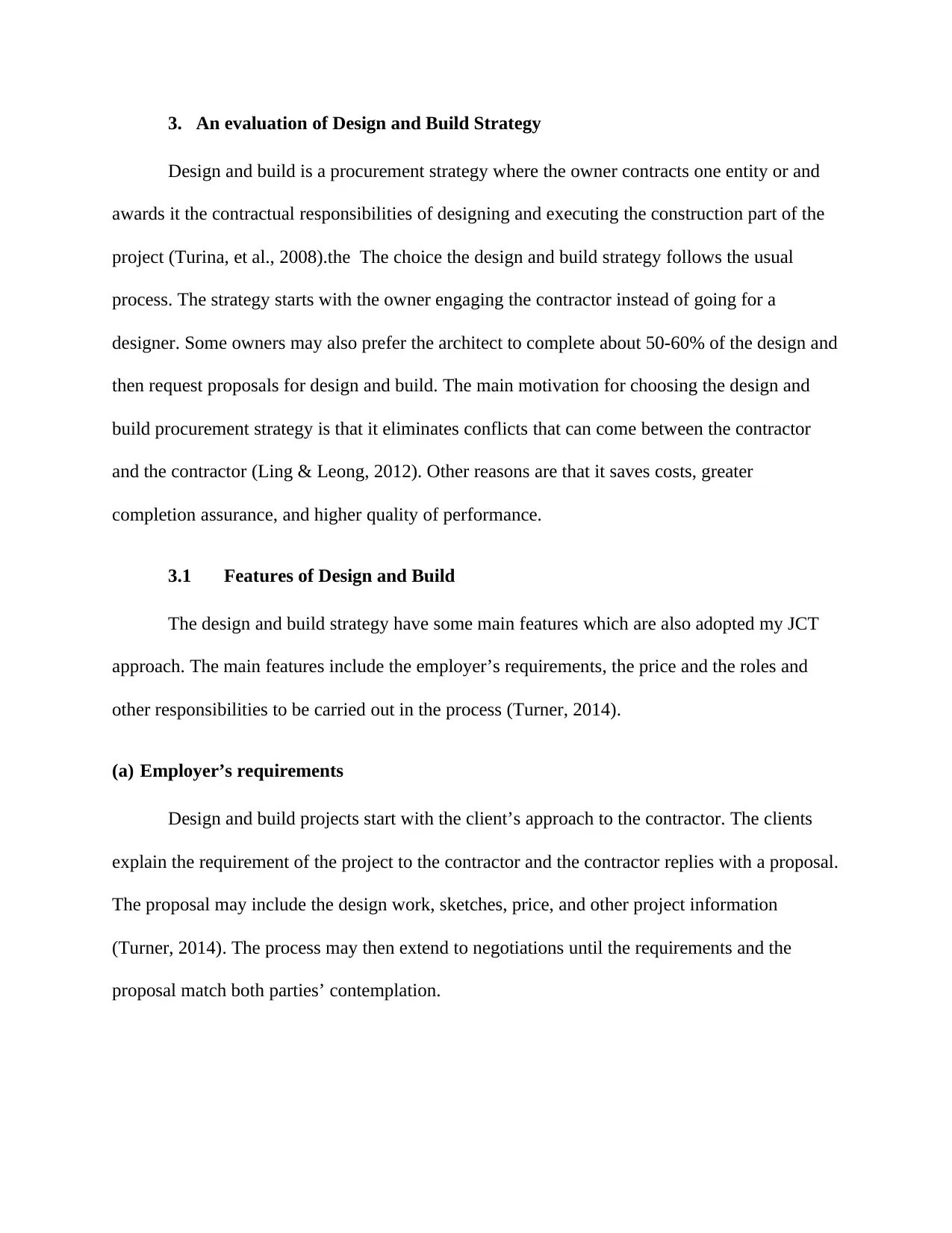
3. An evaluation of Design and Build Strategy
Design and build is a procurement strategy where the owner contracts one entity or and
awards it the contractual responsibilities of designing and executing the construction part of the
project (Turina, et al., 2008).the The choice the design and build strategy follows the usual
process. The strategy starts with the owner engaging the contractor instead of going for a
designer. Some owners may also prefer the architect to complete about 50-60% of the design and
then request proposals for design and build. The main motivation for choosing the design and
build procurement strategy is that it eliminates conflicts that can come between the contractor
and the contractor (Ling & Leong, 2012). Other reasons are that it saves costs, greater
completion assurance, and higher quality of performance.
3.1 Features of Design and Build
The design and build strategy have some main features which are also adopted my JCT
approach. The main features include the employer’s requirements, the price and the roles and
other responsibilities to be carried out in the process (Turner, 2014).
(a) Employer’s requirements
Design and build projects start with the client’s approach to the contractor. The clients
explain the requirement of the project to the contractor and the contractor replies with a proposal.
The proposal may include the design work, sketches, price, and other project information
(Turner, 2014). The process may then extend to negotiations until the requirements and the
proposal match both parties’ contemplation.
Design and build is a procurement strategy where the owner contracts one entity or and
awards it the contractual responsibilities of designing and executing the construction part of the
project (Turina, et al., 2008).the The choice the design and build strategy follows the usual
process. The strategy starts with the owner engaging the contractor instead of going for a
designer. Some owners may also prefer the architect to complete about 50-60% of the design and
then request proposals for design and build. The main motivation for choosing the design and
build procurement strategy is that it eliminates conflicts that can come between the contractor
and the contractor (Ling & Leong, 2012). Other reasons are that it saves costs, greater
completion assurance, and higher quality of performance.
3.1 Features of Design and Build
The design and build strategy have some main features which are also adopted my JCT
approach. The main features include the employer’s requirements, the price and the roles and
other responsibilities to be carried out in the process (Turner, 2014).
(a) Employer’s requirements
Design and build projects start with the client’s approach to the contractor. The clients
explain the requirement of the project to the contractor and the contractor replies with a proposal.
The proposal may include the design work, sketches, price, and other project information
(Turner, 2014). The process may then extend to negotiations until the requirements and the
proposal match both parties’ contemplation.
⊘ This is a preview!⊘
Do you want full access?
Subscribe today to unlock all pages.

Trusted by 1+ million students worldwide
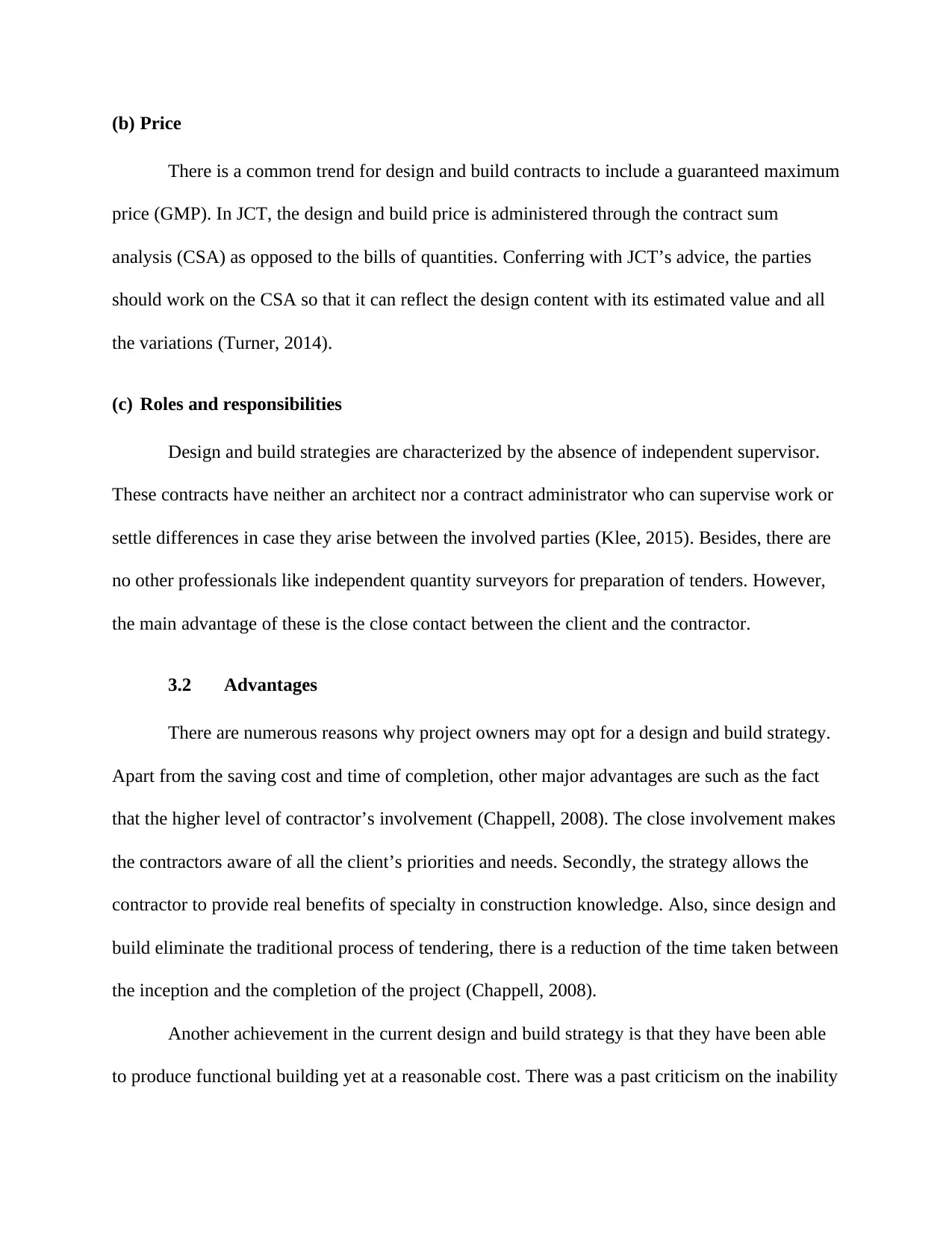
(b) Price
There is a common trend for design and build contracts to include a guaranteed maximum
price (GMP). In JCT, the design and build price is administered through the contract sum
analysis (CSA) as opposed to the bills of quantities. Conferring with JCT’s advice, the parties
should work on the CSA so that it can reflect the design content with its estimated value and all
the variations (Turner, 2014).
(c) Roles and responsibilities
Design and build strategies are characterized by the absence of independent supervisor.
These contracts have neither an architect nor a contract administrator who can supervise work or
settle differences in case they arise between the involved parties (Klee, 2015). Besides, there are
no other professionals like independent quantity surveyors for preparation of tenders. However,
the main advantage of these is the close contact between the client and the contractor.
3.2 Advantages
There are numerous reasons why project owners may opt for a design and build strategy.
Apart from the saving cost and time of completion, other major advantages are such as the fact
that the higher level of contractor’s involvement (Chappell, 2008). The close involvement makes
the contractors aware of all the client’s priorities and needs. Secondly, the strategy allows the
contractor to provide real benefits of specialty in construction knowledge. Also, since design and
build eliminate the traditional process of tendering, there is a reduction of the time taken between
the inception and the completion of the project (Chappell, 2008).
Another achievement in the current design and build strategy is that they have been able
to produce functional building yet at a reasonable cost. There was a past criticism on the inability
There is a common trend for design and build contracts to include a guaranteed maximum
price (GMP). In JCT, the design and build price is administered through the contract sum
analysis (CSA) as opposed to the bills of quantities. Conferring with JCT’s advice, the parties
should work on the CSA so that it can reflect the design content with its estimated value and all
the variations (Turner, 2014).
(c) Roles and responsibilities
Design and build strategies are characterized by the absence of independent supervisor.
These contracts have neither an architect nor a contract administrator who can supervise work or
settle differences in case they arise between the involved parties (Klee, 2015). Besides, there are
no other professionals like independent quantity surveyors for preparation of tenders. However,
the main advantage of these is the close contact between the client and the contractor.
3.2 Advantages
There are numerous reasons why project owners may opt for a design and build strategy.
Apart from the saving cost and time of completion, other major advantages are such as the fact
that the higher level of contractor’s involvement (Chappell, 2008). The close involvement makes
the contractors aware of all the client’s priorities and needs. Secondly, the strategy allows the
contractor to provide real benefits of specialty in construction knowledge. Also, since design and
build eliminate the traditional process of tendering, there is a reduction of the time taken between
the inception and the completion of the project (Chappell, 2008).
Another achievement in the current design and build strategy is that they have been able
to produce functional building yet at a reasonable cost. There was a past criticism on the inability
Paraphrase This Document
Need a fresh take? Get an instant paraphrase of this document with our AI Paraphraser
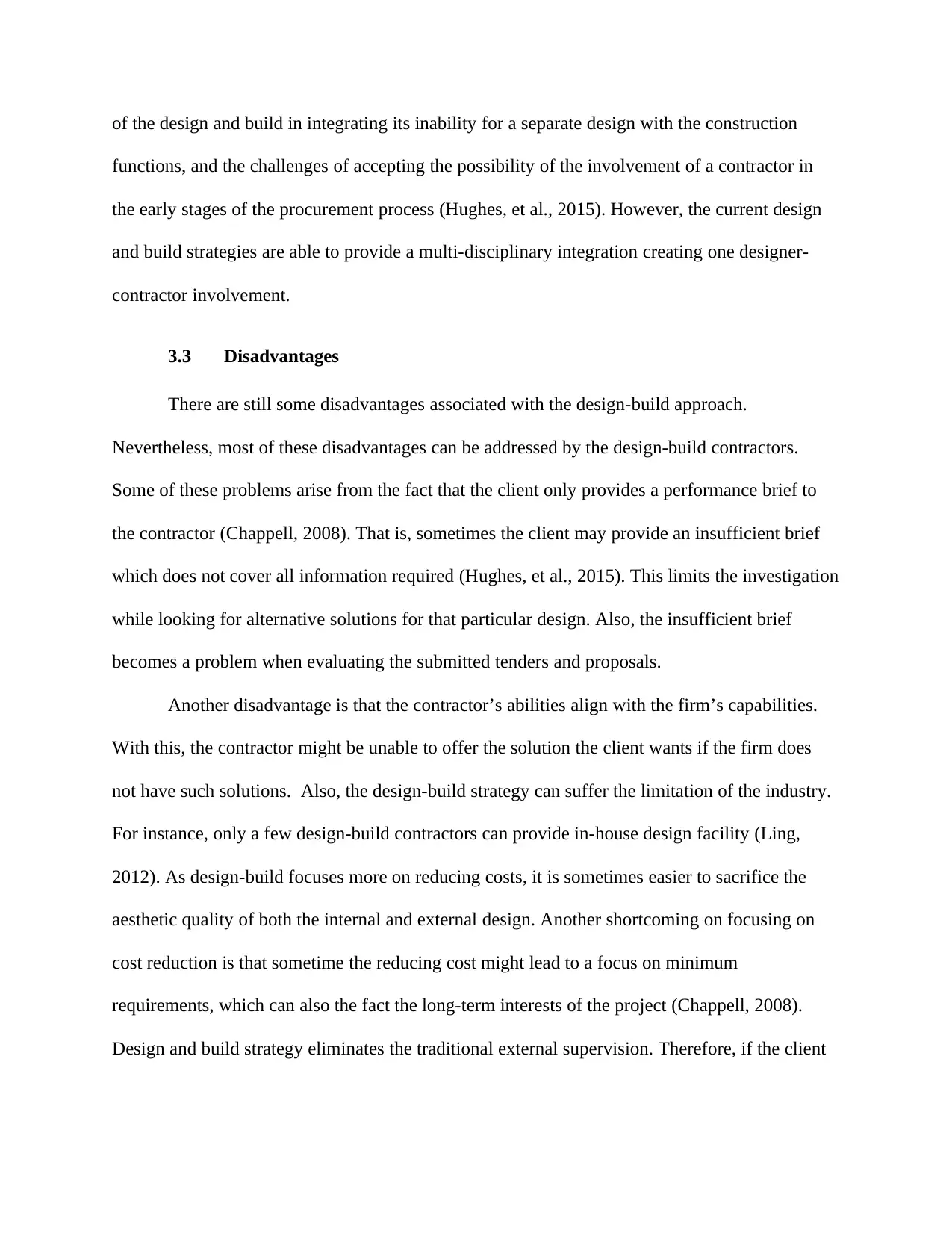
of the design and build in integrating its inability for a separate design with the construction
functions, and the challenges of accepting the possibility of the involvement of a contractor in
the early stages of the procurement process (Hughes, et al., 2015). However, the current design
and build strategies are able to provide a multi-disciplinary integration creating one designer-
contractor involvement.
3.3 Disadvantages
There are still some disadvantages associated with the design-build approach.
Nevertheless, most of these disadvantages can be addressed by the design-build contractors.
Some of these problems arise from the fact that the client only provides a performance brief to
the contractor (Chappell, 2008). That is, sometimes the client may provide an insufficient brief
which does not cover all information required (Hughes, et al., 2015). This limits the investigation
while looking for alternative solutions for that particular design. Also, the insufficient brief
becomes a problem when evaluating the submitted tenders and proposals.
Another disadvantage is that the contractor’s abilities align with the firm’s capabilities.
With this, the contractor might be unable to offer the solution the client wants if the firm does
not have such solutions. Also, the design-build strategy can suffer the limitation of the industry.
For instance, only a few design-build contractors can provide in-house design facility (Ling,
2012). As design-build focuses more on reducing costs, it is sometimes easier to sacrifice the
aesthetic quality of both the internal and external design. Another shortcoming on focusing on
cost reduction is that sometime the reducing cost might lead to a focus on minimum
requirements, which can also the fact the long-term interests of the project (Chappell, 2008).
Design and build strategy eliminates the traditional external supervision. Therefore, if the client
functions, and the challenges of accepting the possibility of the involvement of a contractor in
the early stages of the procurement process (Hughes, et al., 2015). However, the current design
and build strategies are able to provide a multi-disciplinary integration creating one designer-
contractor involvement.
3.3 Disadvantages
There are still some disadvantages associated with the design-build approach.
Nevertheless, most of these disadvantages can be addressed by the design-build contractors.
Some of these problems arise from the fact that the client only provides a performance brief to
the contractor (Chappell, 2008). That is, sometimes the client may provide an insufficient brief
which does not cover all information required (Hughes, et al., 2015). This limits the investigation
while looking for alternative solutions for that particular design. Also, the insufficient brief
becomes a problem when evaluating the submitted tenders and proposals.
Another disadvantage is that the contractor’s abilities align with the firm’s capabilities.
With this, the contractor might be unable to offer the solution the client wants if the firm does
not have such solutions. Also, the design-build strategy can suffer the limitation of the industry.
For instance, only a few design-build contractors can provide in-house design facility (Ling,
2012). As design-build focuses more on reducing costs, it is sometimes easier to sacrifice the
aesthetic quality of both the internal and external design. Another shortcoming on focusing on
cost reduction is that sometime the reducing cost might lead to a focus on minimum
requirements, which can also the fact the long-term interests of the project (Chappell, 2008).
Design and build strategy eliminates the traditional external supervision. Therefore, if the client
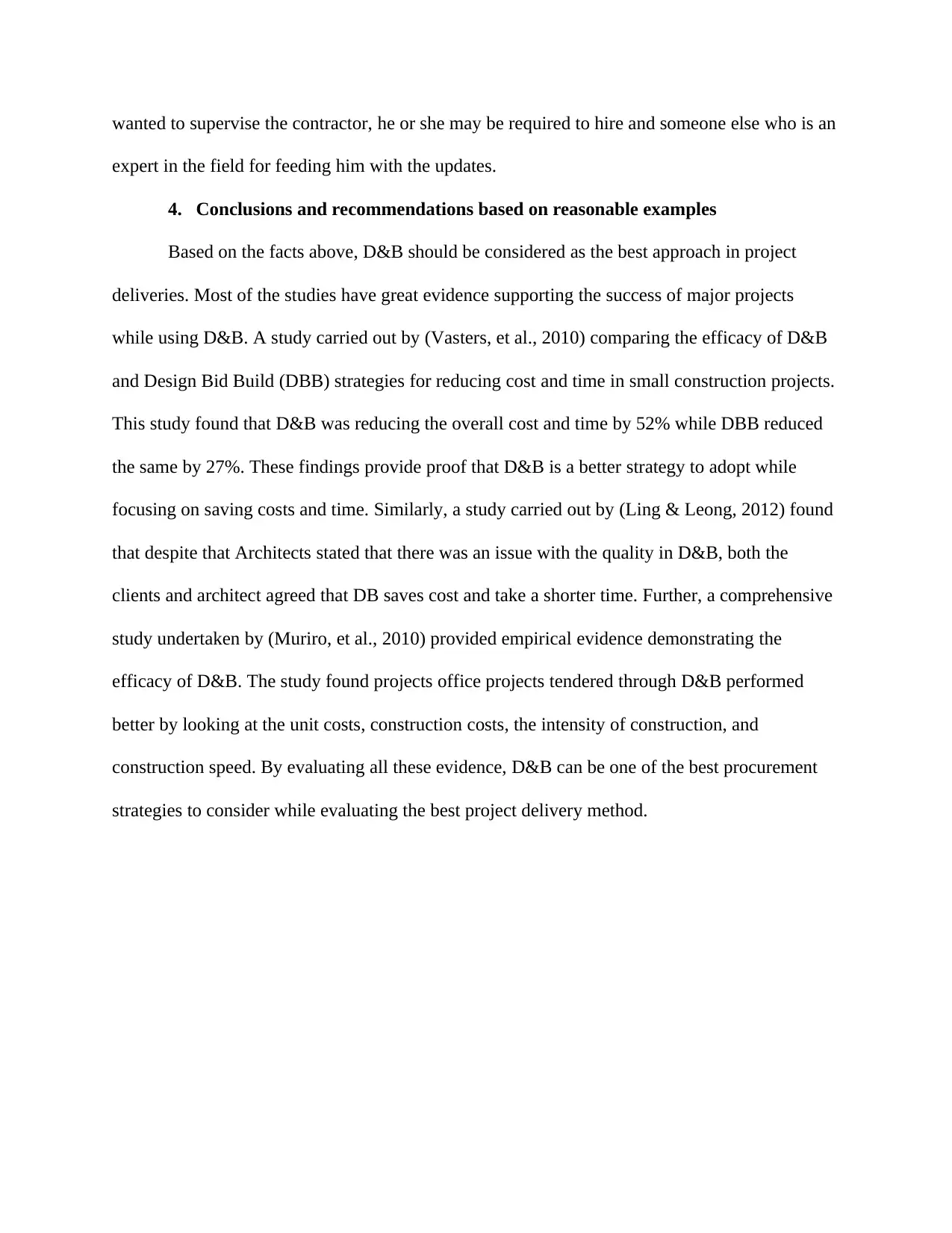
wanted to supervise the contractor, he or she may be required to hire and someone else who is an
expert in the field for feeding him with the updates.
4. Conclusions and recommendations based on reasonable examples
Based on the facts above, D&B should be considered as the best approach in project
deliveries. Most of the studies have great evidence supporting the success of major projects
while using D&B. A study carried out by (Vasters, et al., 2010) comparing the efficacy of D&B
and Design Bid Build (DBB) strategies for reducing cost and time in small construction projects.
This study found that D&B was reducing the overall cost and time by 52% while DBB reduced
the same by 27%. These findings provide proof that D&B is a better strategy to adopt while
focusing on saving costs and time. Similarly, a study carried out by (Ling & Leong, 2012) found
that despite that Architects stated that there was an issue with the quality in D&B, both the
clients and architect agreed that DB saves cost and take a shorter time. Further, a comprehensive
study undertaken by (Muriro, et al., 2010) provided empirical evidence demonstrating the
efficacy of D&B. The study found projects office projects tendered through D&B performed
better by looking at the unit costs, construction costs, the intensity of construction, and
construction speed. By evaluating all these evidence, D&B can be one of the best procurement
strategies to consider while evaluating the best project delivery method.
expert in the field for feeding him with the updates.
4. Conclusions and recommendations based on reasonable examples
Based on the facts above, D&B should be considered as the best approach in project
deliveries. Most of the studies have great evidence supporting the success of major projects
while using D&B. A study carried out by (Vasters, et al., 2010) comparing the efficacy of D&B
and Design Bid Build (DBB) strategies for reducing cost and time in small construction projects.
This study found that D&B was reducing the overall cost and time by 52% while DBB reduced
the same by 27%. These findings provide proof that D&B is a better strategy to adopt while
focusing on saving costs and time. Similarly, a study carried out by (Ling & Leong, 2012) found
that despite that Architects stated that there was an issue with the quality in D&B, both the
clients and architect agreed that DB saves cost and take a shorter time. Further, a comprehensive
study undertaken by (Muriro, et al., 2010) provided empirical evidence demonstrating the
efficacy of D&B. The study found projects office projects tendered through D&B performed
better by looking at the unit costs, construction costs, the intensity of construction, and
construction speed. By evaluating all these evidence, D&B can be one of the best procurement
strategies to consider while evaluating the best project delivery method.
⊘ This is a preview!⊘
Do you want full access?
Subscribe today to unlock all pages.

Trusted by 1+ million students worldwide
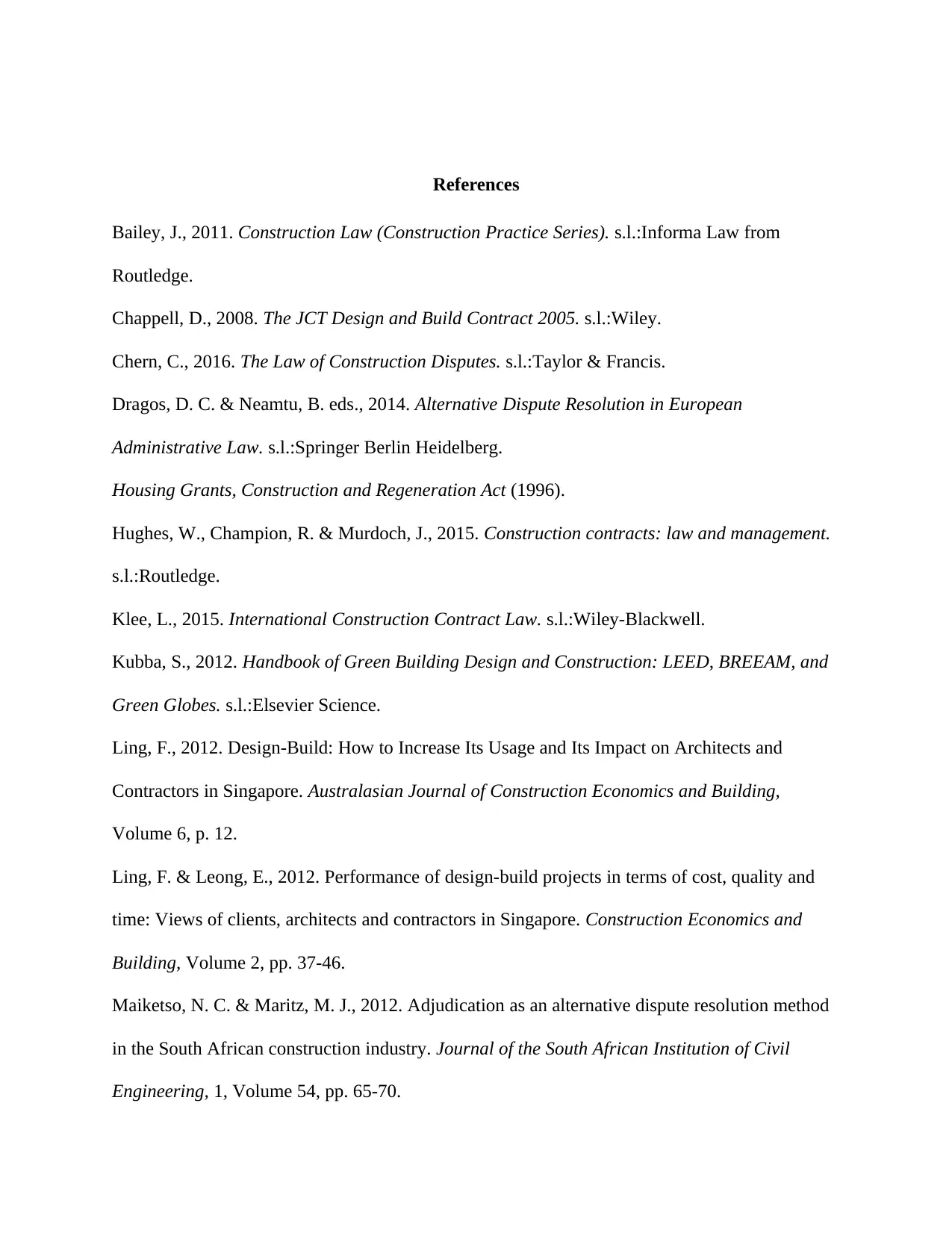
References
Bailey, J., 2011. Construction Law (Construction Practice Series). s.l.:Informa Law from
Routledge.
Chappell, D., 2008. The JCT Design and Build Contract 2005. s.l.:Wiley.
Chern, C., 2016. The Law of Construction Disputes. s.l.:Taylor & Francis.
Dragos, D. C. & Neamtu, B. eds., 2014. Alternative Dispute Resolution in European
Administrative Law. s.l.:Springer Berlin Heidelberg.
Housing Grants, Construction and Regeneration Act (1996).
Hughes, W., Champion, R. & Murdoch, J., 2015. Construction contracts: law and management.
s.l.:Routledge.
Klee, L., 2015. International Construction Contract Law. s.l.:Wiley-Blackwell.
Kubba, S., 2012. Handbook of Green Building Design and Construction: LEED, BREEAM, and
Green Globes. s.l.:Elsevier Science.
Ling, F., 2012. Design-Build: How to Increase Its Usage and Its Impact on Architects and
Contractors in Singapore. Australasian Journal of Construction Economics and Building,
Volume 6, p. 12.
Ling, F. & Leong, E., 2012. Performance of design-build projects in terms of cost, quality and
time: Views of clients, architects and contractors in Singapore. Construction Economics and
Building, Volume 2, pp. 37-46.
Maiketso, N. C. & Maritz, M. J., 2012. Adjudication as an alternative dispute resolution method
in the South African construction industry. Journal of the South African Institution of Civil
Engineering, 1, Volume 54, pp. 65-70.
Bailey, J., 2011. Construction Law (Construction Practice Series). s.l.:Informa Law from
Routledge.
Chappell, D., 2008. The JCT Design and Build Contract 2005. s.l.:Wiley.
Chern, C., 2016. The Law of Construction Disputes. s.l.:Taylor & Francis.
Dragos, D. C. & Neamtu, B. eds., 2014. Alternative Dispute Resolution in European
Administrative Law. s.l.:Springer Berlin Heidelberg.
Housing Grants, Construction and Regeneration Act (1996).
Hughes, W., Champion, R. & Murdoch, J., 2015. Construction contracts: law and management.
s.l.:Routledge.
Klee, L., 2015. International Construction Contract Law. s.l.:Wiley-Blackwell.
Kubba, S., 2012. Handbook of Green Building Design and Construction: LEED, BREEAM, and
Green Globes. s.l.:Elsevier Science.
Ling, F., 2012. Design-Build: How to Increase Its Usage and Its Impact on Architects and
Contractors in Singapore. Australasian Journal of Construction Economics and Building,
Volume 6, p. 12.
Ling, F. & Leong, E., 2012. Performance of design-build projects in terms of cost, quality and
time: Views of clients, architects and contractors in Singapore. Construction Economics and
Building, Volume 2, pp. 37-46.
Maiketso, N. C. & Maritz, M. J., 2012. Adjudication as an alternative dispute resolution method
in the South African construction industry. Journal of the South African Institution of Civil
Engineering, 1, Volume 54, pp. 65-70.
Paraphrase This Document
Need a fresh take? Get an instant paraphrase of this document with our AI Paraphraser
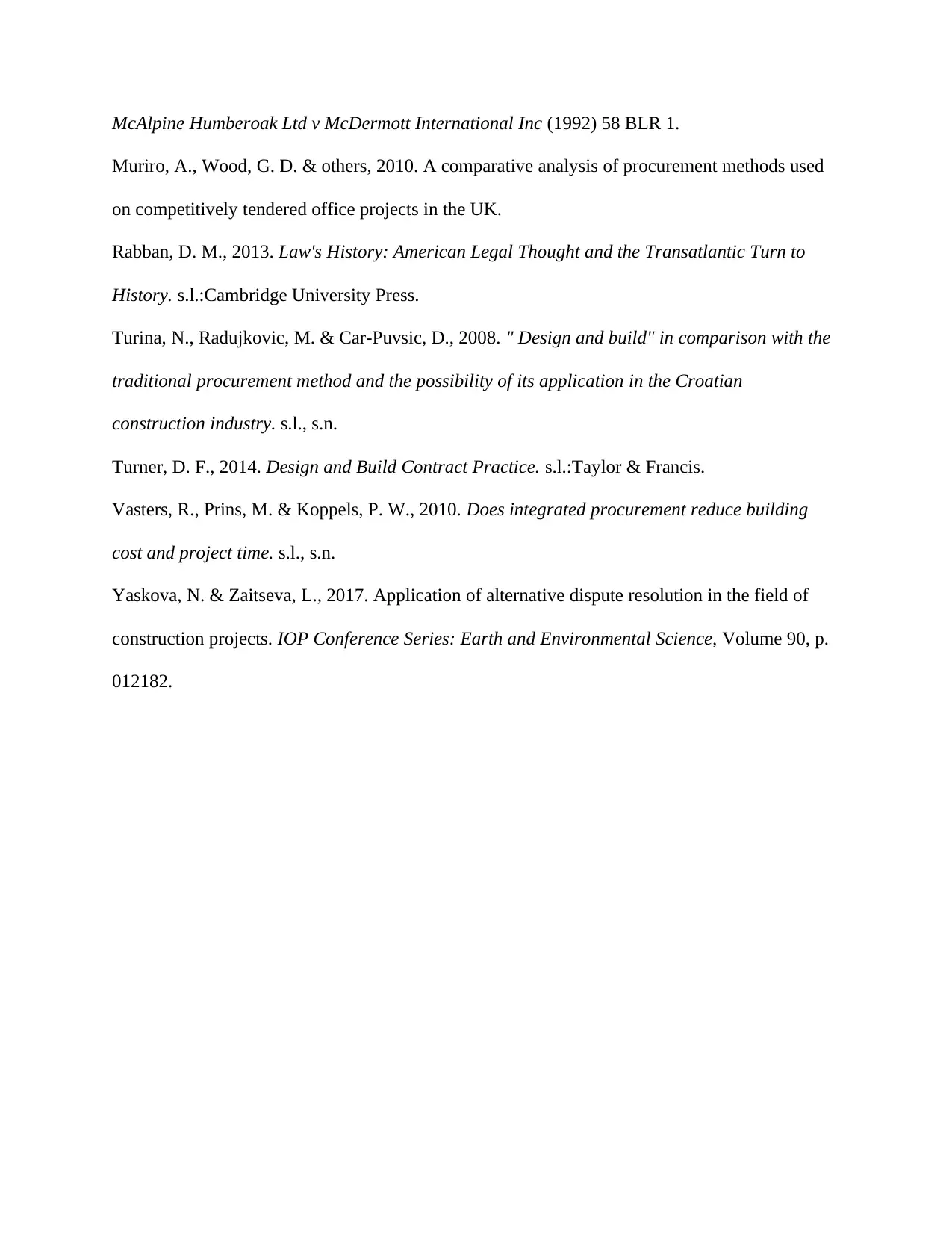
McAlpine Humberoak Ltd v McDermott International Inc (1992) 58 BLR 1.
Muriro, A., Wood, G. D. & others, 2010. A comparative analysis of procurement methods used
on competitively tendered office projects in the UK.
Rabban, D. M., 2013. Law's History: American Legal Thought and the Transatlantic Turn to
History. s.l.:Cambridge University Press.
Turina, N., Radujkovic, M. & Car-Puvsic, D., 2008. " Design and build" in comparison with the
traditional procurement method and the possibility of its application in the Croatian
construction industry. s.l., s.n.
Turner, D. F., 2014. Design and Build Contract Practice. s.l.:Taylor & Francis.
Vasters, R., Prins, M. & Koppels, P. W., 2010. Does integrated procurement reduce building
cost and project time. s.l., s.n.
Yaskova, N. & Zaitseva, L., 2017. Application of alternative dispute resolution in the field of
construction projects. IOP Conference Series: Earth and Environmental Science, Volume 90, p.
012182.
Muriro, A., Wood, G. D. & others, 2010. A comparative analysis of procurement methods used
on competitively tendered office projects in the UK.
Rabban, D. M., 2013. Law's History: American Legal Thought and the Transatlantic Turn to
History. s.l.:Cambridge University Press.
Turina, N., Radujkovic, M. & Car-Puvsic, D., 2008. " Design and build" in comparison with the
traditional procurement method and the possibility of its application in the Croatian
construction industry. s.l., s.n.
Turner, D. F., 2014. Design and Build Contract Practice. s.l.:Taylor & Francis.
Vasters, R., Prins, M. & Koppels, P. W., 2010. Does integrated procurement reduce building
cost and project time. s.l., s.n.
Yaskova, N. & Zaitseva, L., 2017. Application of alternative dispute resolution in the field of
construction projects. IOP Conference Series: Earth and Environmental Science, Volume 90, p.
012182.
1 out of 11
Related Documents
Your All-in-One AI-Powered Toolkit for Academic Success.
+13062052269
info@desklib.com
Available 24*7 on WhatsApp / Email
![[object Object]](/_next/static/media/star-bottom.7253800d.svg)
Unlock your academic potential
Copyright © 2020–2025 A2Z Services. All Rights Reserved. Developed and managed by ZUCOL.





